Showing Spotlights 201 - 208 of 240 in category All (newest first):
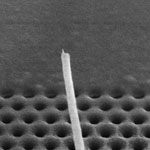 Much is being written about nanotechnology's role in vastly improving the detection and treatment of cancer. Detection of cancer at the earliest stage provides the greatest chance of survival. Unfortunately, cancer has a logarithmic growth rate. A one cubic centimeter size tumor may have 40-50 cell divisions and typically doctors don't see 80% of the life of a tumor. The detection of a protein pattern in blood serum can be helpful in evidencing a possible presence of cancer at an early stage. The problem is that 'early' means the capability of detecting very few molecules in dilute conditions. Now, in another step to improve the design and fabrication of devices for single molecule detection, new research has demonstrated an experimental capability of detecting down to as few as 10 organic molecules deposited on a quantum dot.
Much is being written about nanotechnology's role in vastly improving the detection and treatment of cancer. Detection of cancer at the earliest stage provides the greatest chance of survival. Unfortunately, cancer has a logarithmic growth rate. A one cubic centimeter size tumor may have 40-50 cell divisions and typically doctors don't see 80% of the life of a tumor. The detection of a protein pattern in blood serum can be helpful in evidencing a possible presence of cancer at an early stage. The problem is that 'early' means the capability of detecting very few molecules in dilute conditions. Now, in another step to improve the design and fabrication of devices for single molecule detection, new research has demonstrated an experimental capability of detecting down to as few as 10 organic molecules deposited on a quantum dot.
Jul 23rd, 2008
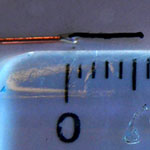 Carbon nanotubes (CNTs) have been widely used as electrodes for chemical and biological sensing applications and many other electrochemical studies. With their unique one-dimensional molecular geometry of a large surface area coupled with their excellent electrical properties, CNTs have become important materials for the molecular engineering of electrode surfaces where the development of electrochemical devices with region-specific electron-transfer capabilities is of paramount importance. It has been demonstrated that carbon nanotubes enhance the electrochemical activity of biomolecules and promote the electron-transfer reactions of redox proteins, such as myoglobin, cyctochrome c, and microperoxidase MP-11. The enhanced electrochemical activity and electron transfer rate at CNT electrodes have been widely believed to arise from the nanotube tips. However, no convincing experimental evidence has been obtained to prove that the CNT tip is more electrochemically active than its sidewall. Contradicting this common belief, researchers have now found that, surprisingly, the electrochemistry at carbon nanotube electrodes is not always facilitated by the nanotube tip. In fact, the relative electrochemical sensitivity of the nanotube tip and sidewall varies for different electrochemical probes proceeding with different reaction mechanisms.
Carbon nanotubes (CNTs) have been widely used as electrodes for chemical and biological sensing applications and many other electrochemical studies. With their unique one-dimensional molecular geometry of a large surface area coupled with their excellent electrical properties, CNTs have become important materials for the molecular engineering of electrode surfaces where the development of electrochemical devices with region-specific electron-transfer capabilities is of paramount importance. It has been demonstrated that carbon nanotubes enhance the electrochemical activity of biomolecules and promote the electron-transfer reactions of redox proteins, such as myoglobin, cyctochrome c, and microperoxidase MP-11. The enhanced electrochemical activity and electron transfer rate at CNT electrodes have been widely believed to arise from the nanotube tips. However, no convincing experimental evidence has been obtained to prove that the CNT tip is more electrochemically active than its sidewall. Contradicting this common belief, researchers have now found that, surprisingly, the electrochemistry at carbon nanotube electrodes is not always facilitated by the nanotube tip. In fact, the relative electrochemical sensitivity of the nanotube tip and sidewall varies for different electrochemical probes proceeding with different reaction mechanisms.
Jun 26th, 2008
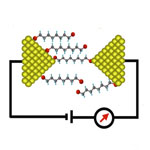 One of the many fascinating concepts in nanotechnology is the vision of molecular electronics where tomorrow's engineers might use individual molecules to perform the functions in an electronic circuit that are performed by semiconductor devices today. This is just another example of scientists taking a cue from nature's playbook, where essentially all electronic processes, from photosynthesis to signal transduction, occur in molecular structures. The basic science on which molecular electronics technology would be built is now unfolding but researchers are still struggling with the most basic requirements for molecular electronics, for instance, how to precisely position individual molecules on a surface or how to reliably measure the resistance of a single molecule. A tremendous amount of painstaking work goes into developing the kind of ultraprecise and ultrasensitive instruments that are required to develop electronics at the nanoscale. A recent example is a new device for measuring the conductance values of single-molecule junctions which are covalently bound to two electrodes.
One of the many fascinating concepts in nanotechnology is the vision of molecular electronics where tomorrow's engineers might use individual molecules to perform the functions in an electronic circuit that are performed by semiconductor devices today. This is just another example of scientists taking a cue from nature's playbook, where essentially all electronic processes, from photosynthesis to signal transduction, occur in molecular structures. The basic science on which molecular electronics technology would be built is now unfolding but researchers are still struggling with the most basic requirements for molecular electronics, for instance, how to precisely position individual molecules on a surface or how to reliably measure the resistance of a single molecule. A tremendous amount of painstaking work goes into developing the kind of ultraprecise and ultrasensitive instruments that are required to develop electronics at the nanoscale. A recent example is a new device for measuring the conductance values of single-molecule junctions which are covalently bound to two electrodes.
May 27th, 2008
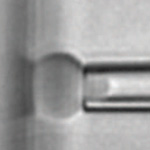 'Reverse engineering' is the process of discovering the technological principles of a device or system through analysis of its structure, function and operation, often by taking it apart and analyzing its workings in detail. This approach is a common practice among industrial companies who use it to analyze the competition's products, be it cars or MP3 players, to understand where the latest product improvements come from and how individual components are made. An increasing number of scientists apply a similar approach to nature's own 'micro- and nanotechnology' systems. They believe that learning from nature's designs and engineering successes is more likely to provide the cues for designing practical nanodevices than by simply applying a 'trial and error' approach. The basic idea is that natural materials and systems can be adopted for human use beyond their original purpose in nature. Some examples of 'reverse' biophysics work and have already proven quite useful, for instance the use of individual red blood cells as reliable, ultrasensitive mechanotransducers.
'Reverse engineering' is the process of discovering the technological principles of a device or system through analysis of its structure, function and operation, often by taking it apart and analyzing its workings in detail. This approach is a common practice among industrial companies who use it to analyze the competition's products, be it cars or MP3 players, to understand where the latest product improvements come from and how individual components are made. An increasing number of scientists apply a similar approach to nature's own 'micro- and nanotechnology' systems. They believe that learning from nature's designs and engineering successes is more likely to provide the cues for designing practical nanodevices than by simply applying a 'trial and error' approach. The basic idea is that natural materials and systems can be adopted for human use beyond their original purpose in nature. Some examples of 'reverse' biophysics work and have already proven quite useful, for instance the use of individual red blood cells as reliable, ultrasensitive mechanotransducers.
May 22nd, 2008
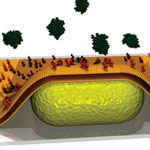 The phenomenon behind many color-based biosensor applications is the excitation of surface plasmons by light - called surface plasmon resonance for planar surfaces or localized surface plasmon resonance (LSPR) for nanoscale metallic structures. Surface plasmon resonance of metallic nanoparticles, in particular gold, has become a popular nanotechnology-enabled technique to build increasingly sensitive and fast biosensors. All the nanostructures used for the biosensing applications have two characteristics: Firstly, they contain certain recognition mechanisms specified to the analyte, for example antibodies or enzymes. Secondly, they are able to generate a distinguishing signal from the analyte and this signal could be generated by the nanostructures themselves or produced by signaling molecules immobilized or contained in the nanostructures. However, proper functionalization remains an issue when it comes to real-world applications, in particular, biological relevant samples such as membrane associated proteins and peptides.
The phenomenon behind many color-based biosensor applications is the excitation of surface plasmons by light - called surface plasmon resonance for planar surfaces or localized surface plasmon resonance (LSPR) for nanoscale metallic structures. Surface plasmon resonance of metallic nanoparticles, in particular gold, has become a popular nanotechnology-enabled technique to build increasingly sensitive and fast biosensors. All the nanostructures used for the biosensing applications have two characteristics: Firstly, they contain certain recognition mechanisms specified to the analyte, for example antibodies or enzymes. Secondly, they are able to generate a distinguishing signal from the analyte and this signal could be generated by the nanostructures themselves or produced by signaling molecules immobilized or contained in the nanostructures. However, proper functionalization remains an issue when it comes to real-world applications, in particular, biological relevant samples such as membrane associated proteins and peptides.
May 15th, 2008
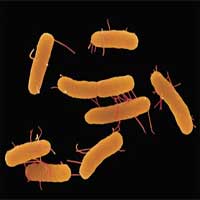 The U.S. Food and Drug Administration has published a handbook called the Bad Bug Book which provides basic facts regarding foodborne pathogenic microorganisms and natural toxins. It contains all you always wanted to know about Salmonella, E. coli, parasitic protozoa, worms, viruses and natural toxins and other stuff that, when it gets in your hamburger, as it does from time to time, can make you pretty sick. It can even kill you. The Centers for Disease Control and Prevention (CDC) keep some pretty scary statistics and estimate that foodborne pathogens cause approximately 76 million illnesses, 325,000 hospitalizations, and 5,000 deaths in the United States each year. Three pathogens, Salmonella, Listeria, and Toxoplasma, are responsible for 1,500 deaths each year. Salmonella is the most common cause of foodborne deaths and responsible for millions of cases of foodborne illness a year. Sources are raw and undercooked eggs, undercooked poultry and meat, dairy products, seafood, fruits and vegetables - so basically more or less everything you eat. Early detection of foodborne pathogenic bacteria, especially Salmonella, is therefore an important task in microbiological analysis to control food safety. Several methods have been developed in order to detect this pathogen; however, the biggest challenges remain detection speed and sensitivity. A novel nanotechnology-based biosensor is showing great potential for foodborne pathogenic bacteria detection with high accuracy.
The U.S. Food and Drug Administration has published a handbook called the Bad Bug Book which provides basic facts regarding foodborne pathogenic microorganisms and natural toxins. It contains all you always wanted to know about Salmonella, E. coli, parasitic protozoa, worms, viruses and natural toxins and other stuff that, when it gets in your hamburger, as it does from time to time, can make you pretty sick. It can even kill you. The Centers for Disease Control and Prevention (CDC) keep some pretty scary statistics and estimate that foodborne pathogens cause approximately 76 million illnesses, 325,000 hospitalizations, and 5,000 deaths in the United States each year. Three pathogens, Salmonella, Listeria, and Toxoplasma, are responsible for 1,500 deaths each year. Salmonella is the most common cause of foodborne deaths and responsible for millions of cases of foodborne illness a year. Sources are raw and undercooked eggs, undercooked poultry and meat, dairy products, seafood, fruits and vegetables - so basically more or less everything you eat. Early detection of foodborne pathogenic bacteria, especially Salmonella, is therefore an important task in microbiological analysis to control food safety. Several methods have been developed in order to detect this pathogen; however, the biggest challenges remain detection speed and sensitivity. A novel nanotechnology-based biosensor is showing great potential for foodborne pathogenic bacteria detection with high accuracy.
Mar 17th, 2008
 Biosensors, which incorporate biological probes coupled to a transducer, have been developed during the last two decades for environmental, industrial, and biomedical diagnostics. Typically, signal sizes generated by biomolecular binding tend to be extremely small - this is the limiting factor in reaching high sensitivity for these sensors. The application of nanotechnology to biosensor design and fabrication and therapy at the molecular and cellular level promises to revolutionize bio-diagnostics. By exploiting the large surface-to-volume ratio of nanowires, nanotubes, nanocrystals, nanocantilevers, or quantum dots, researchers were able to build sensors that can measure extremely faint, and otherwise undetectable, signals - for instance a change in electrical conductance - arising from biomolecular binding on the surface of these nanodevices. Highly sensitive nanoprobes and nanosensors have the potential for a wide variety of medical uses at the cellular level. For instance, the potential for monitoring in vivo biological processes within single living cells, e.g. the capacity to sense individual chemical species in specific locations within a cell, will greatly improve our understanding of cellular function, thereby revolutionizing cell biology. One way of enhancing signal strength is on the sensor device itself and researchers have now demonstrated such an on-chip signal amplification using a standard protein on a nanoscale field effect transistor.
Biosensors, which incorporate biological probes coupled to a transducer, have been developed during the last two decades for environmental, industrial, and biomedical diagnostics. Typically, signal sizes generated by biomolecular binding tend to be extremely small - this is the limiting factor in reaching high sensitivity for these sensors. The application of nanotechnology to biosensor design and fabrication and therapy at the molecular and cellular level promises to revolutionize bio-diagnostics. By exploiting the large surface-to-volume ratio of nanowires, nanotubes, nanocrystals, nanocantilevers, or quantum dots, researchers were able to build sensors that can measure extremely faint, and otherwise undetectable, signals - for instance a change in electrical conductance - arising from biomolecular binding on the surface of these nanodevices. Highly sensitive nanoprobes and nanosensors have the potential for a wide variety of medical uses at the cellular level. For instance, the potential for monitoring in vivo biological processes within single living cells, e.g. the capacity to sense individual chemical species in specific locations within a cell, will greatly improve our understanding of cellular function, thereby revolutionizing cell biology. One way of enhancing signal strength is on the sensor device itself and researchers have now demonstrated such an on-chip signal amplification using a standard protein on a nanoscale field effect transistor.
Jan 22nd, 2008
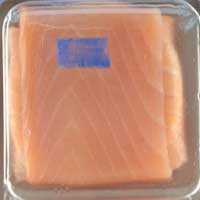 Most people when they hear the word semiconductor will think about their role in computers. However, semiconductors also absorb light, some absorb in the visible, thus appearing colored, e.g. gray silicon, and others in the UV, such as titanium dioxide, thus appearing white (when in microparticulate form) or colorless (when in nanoparticulate form). This light-absorbing feature is used to drive electrons around a circuit in photovoltaic cells, such as the silicon solar cell, but it can also be used to drive chemical reactions at the surface. A good example of the latter is the use of thin (15 nm) titanium dioxide film coatings on self-cleaning glass. These films upon absorbing UV light in sunlight are able to reduce oxygen, present in air, to water and oxidize any organic material on its surface to its minerals, thereby keeping the surface clean. Researchers in the UK have used this oxidation feature to developed an irreversible solvent-based blue ink, which upon activation with UV light, loses all its color and becomes oxygen sensitive; it will only gain its original color upon exposure to oxygen. A major application area for this oxygen ink is in food packaging where it could be used to detect a modified atmosphere inside food containers.
Most people when they hear the word semiconductor will think about their role in computers. However, semiconductors also absorb light, some absorb in the visible, thus appearing colored, e.g. gray silicon, and others in the UV, such as titanium dioxide, thus appearing white (when in microparticulate form) or colorless (when in nanoparticulate form). This light-absorbing feature is used to drive electrons around a circuit in photovoltaic cells, such as the silicon solar cell, but it can also be used to drive chemical reactions at the surface. A good example of the latter is the use of thin (15 nm) titanium dioxide film coatings on self-cleaning glass. These films upon absorbing UV light in sunlight are able to reduce oxygen, present in air, to water and oxidize any organic material on its surface to its minerals, thereby keeping the surface clean. Researchers in the UK have used this oxidation feature to developed an irreversible solvent-based blue ink, which upon activation with UV light, loses all its color and becomes oxygen sensitive; it will only gain its original color upon exposure to oxygen. A major application area for this oxygen ink is in food packaging where it could be used to detect a modified atmosphere inside food containers.
Jan 17th, 2008
 Much is being written about nanotechnology's role in vastly improving the detection and treatment of cancer. Detection of cancer at the earliest stage provides the greatest chance of survival. Unfortunately, cancer has a logarithmic growth rate. A one cubic centimeter size tumor may have 40-50 cell divisions and typically doctors don't see 80% of the life of a tumor. The detection of a protein pattern in blood serum can be helpful in evidencing a possible presence of cancer at an early stage. The problem is that 'early' means the capability of detecting very few molecules in dilute conditions. Now, in another step to improve the design and fabrication of devices for single molecule detection, new research has demonstrated an experimental capability of detecting down to as few as 10 organic molecules deposited on a quantum dot.
Much is being written about nanotechnology's role in vastly improving the detection and treatment of cancer. Detection of cancer at the earliest stage provides the greatest chance of survival. Unfortunately, cancer has a logarithmic growth rate. A one cubic centimeter size tumor may have 40-50 cell divisions and typically doctors don't see 80% of the life of a tumor. The detection of a protein pattern in blood serum can be helpful in evidencing a possible presence of cancer at an early stage. The problem is that 'early' means the capability of detecting very few molecules in dilute conditions. Now, in another step to improve the design and fabrication of devices for single molecule detection, new research has demonstrated an experimental capability of detecting down to as few as 10 organic molecules deposited on a quantum dot. 
 Subscribe to our Nanotechnology Spotlight feed
Subscribe to our Nanotechnology Spotlight feed





